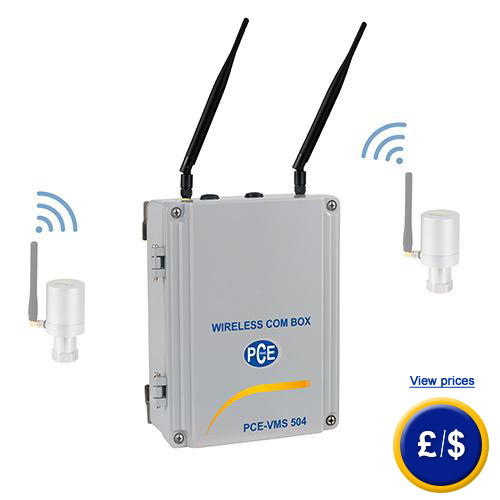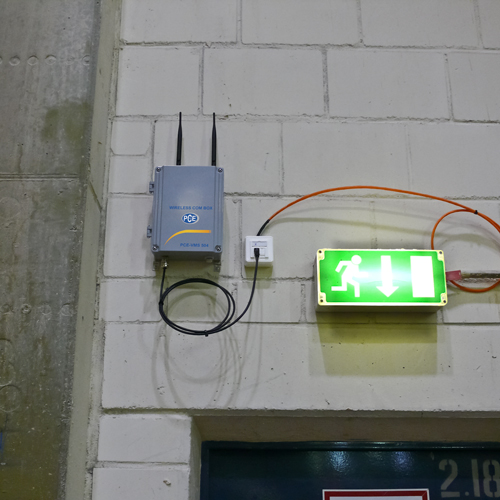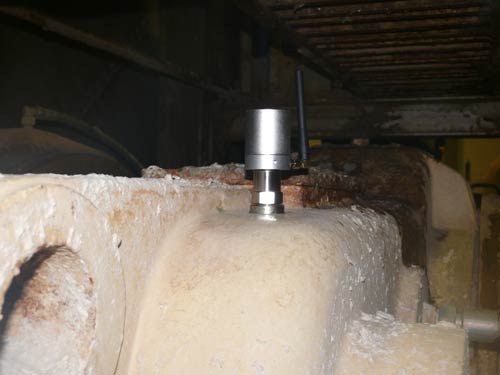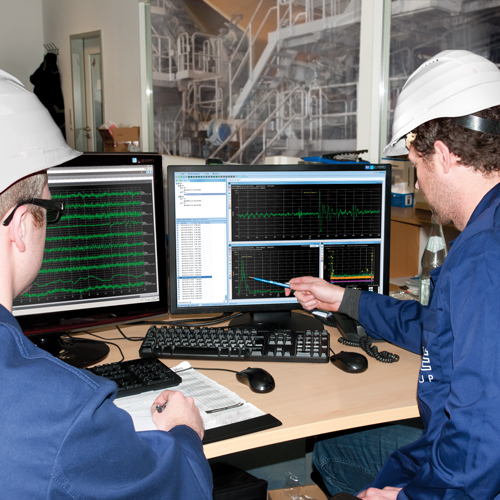|
|
|
- Contact
us Other instruments: - Measures
-
Scales |
|
Wireless
Vibration Monitor PCE-VMS 504 |
|
|
The
wireless vibration monitor PCE-VMS 504 detects vibration within an acceleration
range of up to 30 g and a frequency range between 5 and 10 KHz. The wireless
vibration monitor therefore features external vibration sensors, which measures
vibrations at machines to transfer those wireless to a receiving unit. Those
sensors can be easily attached to a machine due to its magnetic base. There they
can not only measure vibrations at machines and transfer those to a computer but
also recognize temperatures between -20 and +120 °C. While operating, the
communicating server of the wireless vibration monitor PCE-VMS 504 sends the
measured parameters straight to a receiving unit, which then uploads the
received data straight to a server. But if the system cannot establish a
connection with the server, the parameter are temporarily saved on the receiving
unit until a server-connection could be re-established. A main advantage of the
wireless vibration monitor is that there are no wires, so that the set-up of the
system is much quicker and easier, while the wireless vibration monitor is able
to record vibrations over a longer period of time. If there are any questions about this
Wireless Vibration Monitor PCE-VMS 504, please
have a look at the technical specification below or call: |
|
|
- Wireless communication via ZigBee |
-
Dispatcher IP 65 protected |
|
Technical Specifications of the Wireless Vibration Monitor |
|
|
Communication type |
ZigBee
(with PCE-VMS 501) |
|
Frequency band |
2.4 GHz |
|
Interfaces |
Ethernet 2.0 IEEE802.3, TCP/IP, 10/100baseT |
|
Data storage capacity |
128 MB |
|
Power supply |
220 VAC or POE |
|
Operating temperature |
-20 ... +50 °C |
|
Dimensions |
250 x 210 x 100 mm |
|
Weight |
2400 g |
|
Technical Specifications about dispatcher of the Wireless Vibration Monitor PCE-VMS 504 |
|
|
Dispatch range |
max.
100 m in industrial environment |
|
Acceleration range |
up to 300 m/s² |
|
Frequency range |
5 Hz ... 10 kHz |
|
Resonance frequency |
16 kHz |
|
Linearity |
1 % |
|
Sensitivity for paramaters that are not relevant for measurement |
≤5 % |
|
Electric insulation |
<108 Ω |
|
Load limit |
1000 g |
|
Measuring parameters |
Acceleration, speed, temperature, offset |
|
Dispatch interval |
min.
1 minute per sensor |
|
A/D conversion |
24 Bit |
|
Measurable range for wave form |
max. 512 kB |
|
Frequency lines |
800, 1600, 3200, 6400 |
|
Measurement range for temperature |
-20 ... +120 °C |
|
Screw thread |
6 mm |
|
Material of enclosure |
Bottom
316 L stainless steel, |
|
Power supply |
1 x 3,6 V lithium battery (ER 34335) |
|
Battery lifetime |
1 year, depending on transfer interval |
|
Dimensions |
height:
80 , |
|
Weight |
217 g |
|
Protection class |
IP 65 |
|
Operation temperature |
-30
... +70 °C |
|
Receiver of wireless vibration monitor PCE-VMS 504 |
|
|
|
|
|
The receiver station of the wireless vibration monitor PCE-VMS 504 is the connection between vibration sensors on the machine and the analysis software MOS2000 installed on a server. After receiving the data about the machine, the receiver dispatches those information via Ethernet to an internal or external server. The power supply is 220 V, but can be effective via POE as well. |
|
|
Vibration sensor of the wireless vibration monitor PCE-VMS 504 |
|
|
|
|
|
The vibration sensor of the wireless vibration monitor can record the oscillation path, oscillation speed and the oscillation acceleration. In addition to these parameters regarding oscillation the wireless vibration sensor can also measure temperatures to a maximum of 120 °C. Due to protection class IP65 the sensors also record reliably the machine data in humid or dusty environments. The sensor not only collects the data but also dispatches those. Depending on the surrounding conditions the sensor is able to send those data over a distance of up to 100 m or even more. The power source of the sensor is a 3.6 V set of batteries with a lifetime of more than a year (depending on the data transfer interval ). The sensor can be coupled in various ways. The wireless vibration monitor features a M6 thread inside the receiving base made of steel. Through the thread you can for example connect the sensor via a stud screw to the oscillating source. The coupling can be performed via a magnetic or a attachable adapter as well. |
|
|
Application of the oscillation analysis software MOS2000 |
|
|
|
|
|
Analysis of oscillation and vibration via the analysis software MOS 2000 |
|
|
The wireless vibration monitor works with a software called MOS 2000, which provides analysts an efficient program for diagnosis and general evolution of the machines' performances according to ISO10816. The software is based on a browser and can be accessed via web. Thus the data can be accessed worldwide. Thus different branches of an industry can be accessed and monitored at the same time. And the analyst does not even need to be on site. |
|
|
You can set up different user profiles at the software, each of which can have their defined access rights. Thus there can be reports generated from the accumulated data sets, transfer intervals can be set or alarm thresholds for borderline oscillation parameters can be defined. On the analysis software of the wireless vibration monitor each production site can be shown in a model of the actual original and be occupied with a measuring slot. Those measuring slots are accordant to the actual vibration sensors on the machine. The measurement slots can be defined regarding the oscillation path, speed and acceleration. Furthermore the frequency range which shall be measured by the vibration sensor, can be defined for each measuring slot individually. Each measuring slot can display a maximum of 3 oscillation parameters. For a further understanding of how to configure a ,measuring slot an example is given in the following: |
|
|
Oscillation speed: |
v
[mm/s] frequency range: f [10 Hz - 1 kHz] |
|
Oscillation acceleration: |
a
[mm/s2] frequency range: f [10 Hz- 10 kHz] |
|
Oscillation acceleration |
a
[mm/s2] frequency range: f [2 Hz- 2000 Hz] |
|
The relevant recorded data are transmitted by the vibration sensor via ZigBee to the receiver base (PCE-VMS 504) and permanently saved on the connected data server. With the software MOS2000 the relevant measuring slot can be reviewed and the results according to the configured parameters can then be read-out with almost real-time speed. The generated data sets are then stored purely as oscillation values in MOS 2000. With that software a variety of analysis tools can be then applied. By means of the analysis software MOS 2000 a detailed prognosis about the quality of the ball gearing' components can be developed afterwards. Many vibration meter often cause a reduced quality and an abrasion on the elements of the machine on which the vibration meter is applied, due to their measuring method, e.g. if a sensor-resonance is measured with the units BCU, SPM etc. That method also does only allow good/bad decisions but no detailed analysis about the magnitude of the damage on outer or inner ring, rolling body or retainer. Since a databank of the rolling body is often integrated by most manufacturers the theoretical damage frequency shown there can be compared to the actual measured oscillation frequencies. Tools, which the MOS 2000 can pick from, are for example: time signal, frequency analysis, waterfall diagram, cepstrum, envelope analysis etc. |
|
|
Time signal: The time signal shows the offset (s[µm]), speed (v [mm/s]) or acceleration (a [mm/s2] [g]) of a measuring point from its position of rest over time. The relevant deflection is defined by its amplitude, frequency and phase angle. A common example therefore is a harmonic sinusoidal oscillation. In reality there are often periodic values throughout the time signal, but since in most cases they are oscillation compounds with a basic oscillation and several high frequency oscillation components, those signals must be demounted for further analysis. Frequency spectrum: The frequency spectrum originates from a Fast-Fourier- Transformation of the time signal. The FFT integral demounts the temporal periodic oscillation into its harmonic oscillation parts and displays the relevant amplitude on a frequency axis. The width of the frequency axis an therefore the measurable frequency range covers in theory 0 Hz to Nyquist frequency, which is half of the sensor's sampling frequency. I.e. to display a frequency of 10 kHz the signal has to be at least sampled with a 20 kHz frequency. Therefore the determined frequency amplitudes allow conclusions about defect our faulty machine parts. Waterfall chart: The waterfall chart displays the frequency spectrum in a three-dimensional form. In addition the z-axis can be assigned with further parameters e.g. revolution, performance or operating time. The vibration monitor visualizes in the z-axis the chronological sequence of the spectral allocation of oscillation. Due to this 3-dimensional visualization amplitude fluctuations or offsets of frequency bands can be shown easily. Cepstrum: The cepstrum analysis is another parameter for detailed analysis of harmonic correlations over the spectral oscillation distribution. The Cepstrum analysis helps detecting quefrencys. Quefrencys are frequency parts which are not recognizable in a pure spectrum. The Cepstrum analysis is a reliable method to monitor gears, since due to the interlock of various waves and gear-wheels there is a cinematic correlation between all of its components. Envelope analysis: The envelope analysis helps uncovering impulse patterns. Those pulse patterns can be caused by faulty gear parts or gear-wheels. Compared to the whole oscillation image within the frequency range of a machine, the amplitudes of those pulse patterns are relatively small and often not distrainable from the general noise. Only the natural frequency of the stimulated components is recognizable. To display the causing pulse patterns the oscillation signal is driven through a bandpass filter, alignment of peak values and a following FFT analysis of the envelope analysis. For an evaluation of the gear-wheels the envelope analysis is an important parameter, since its facilitates detecting pulse patterns that would not be visible in a common spectral analysis of the vibration. |
|
|
Delivery
Content of the Wireless Vibration Monitor PCE-VMS 504: |
|
|
Optional Equipment of the Wireless Vibration Monitor PCE-VMS 504: |
|
|
PCE-VMS 501 |
Oscillation
sensor, magnetic feet Ĝ 20 mm), |
|
PCE-VMS AD1 |
Adapter for pipelines (Ĝ 100 mm) |
|
PCE-VMS AD5 |
Adapter for pipelines (Ĝ 500 mm) |
|
PCE-VMS AD10 |
Adapter for pipelines (Ĝ 1000 mm) |
|
SG-527 |
Glue for metal to attach adapter |
|
PCE-VMS-PC |
Server for monitoring software / supervision of data bases (necessary, if customer hasn't already its own server) |
|
PCE-VMS-CAL |
Calibration certificate (1-point initial calibration by manufacturer), per uniaxial sensor |
|
PCE-VMS-CAL2 |
Calibration certificate (1-point recalibration by manufacturer), per uniaxial sensor |
|
Optional Service for Wireless Vibration Monitor: |
|
|
PCE-VMS-IB |
Set up of monitoring system |
|
PCE-VMS-SV |
Maintenance on site |
|
PCE-VMS-FW |
Monitoring remote desktop maintenance (for analysis of oscillation graphs or oscillation data) |
|
Similar products to the Wireless Vibration Monitor: |
|
|
|||||
| Here you will find an overview of all the measuring instruments available at PCE Instruments. | |||||
|
Contact: |
Contact: |
||||
|
Below you will find an overview of the different product groups of measuring instruments |
||||||||||||||||||||||||
|
|
|
|
|||||||||||||||||||||
|
Below you will find an overview of the different product groups of scales and scales |
|||||||||||||||||||||||
|
|
|
|
||||||||||||||||||||





























































